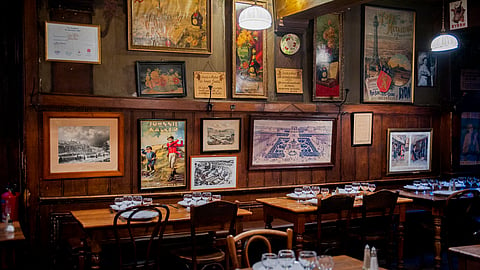
- Destinations
- Experiences
- Stay
- What's new
- Editor’s Picks
- Responsible Tourism
- CampaignsCampaigns
- Subscribe

Lyon is France’s capital of gastronomy. Not only can you enjoy dishes from all over the world but the city itself has a distinctive cuisine that attracts foodies from within and outside the country. Dishes like cervelle de canut, rosette de Lyon, saucisson de Lyon, quenelles and poulet au vinaigre are served in bouchons, a type of restaurant found only in the city that serves traditional Lyonnaise cuisine. Due to its location in the wine-producing region of Rhône, the city also has some of the best French wines you can taste on your visit here.
Here’s how to get the most out of Lyon’s food heritage.
There is no better breakfast offering than mâchon, Lyon's equivalent to a good English breakfast. It consists of hearty dishes like Andouillette sausage, mashed potato canapés, walnut and endive salad, ham and parsley pâté, and creamy herbed cheese. The meal uses all parts of an animal so that nothing goes to waste. The tradition dates back to the canuts, silk weavers who settled in Lyon’s Croix-Rousse district in the 19th century. After a night of hard work, they enjoyed a "pot Lyonnais" of pork with red wine from Beaujolais or Mâconnais. Eat mâchon at bouchons like Le Vivarais, La Meunière, Les 4G and Le Café du Peintre, among other places.
If you’re in the mood for cinnamon brioche rolls or granola, then try Le Kitchen Café. Their “La Totale” deal costs INR 935 (EUR 10). For those keen to get their vitamin intake first thing in the morning, visit L'Estanco du Marché. Pick their açai bowl or homemade granola with soy yoghurt, fresh fruit and goji berries. Le Desjeuneur is ideal for pancake lovers while Pimprenelle serves baked eggs, different types of breads, jams, brioche, cakes and more.
In the afternoon, sample quenelle de brochet. Made from pike fish and bread crumbs, these light and airy parcels are typically served with a rich, creamy lobster or crayfish sauce known as Nantua. The texture of the quenelle is a pleasant mix between fluffy and firm. They are a main course in most restaurants like the Daniel et Denise Créqui, the Café Comptoir Abel, Bouchon Thomas and Le Bouchon des Cordeliers.
Another main dish you should try is salade lyonnaise with pâté en croûte. The salad is an iconic dish that combines curly endive lettuce with crisp lardons (small strips or cubes of pork fat), perfectly poached eggs and crunchy croutons. The warm bacon fat dressing poured over the salad slightly wilts the greens and gives the dish a savoury punch. The pâté en croûte is cooked pâté in shortcrust pastry. The shortcrust is filled with pork, veal or chicken meat, marinated in a mixture of wine, bay leaves and spices, and mixed with duck foie gras.
Wrap it all up with bugnes lyonnaises, a variation of beignet which is a pastry made from deep-fried dough that is sprinkled with icing sugar—sort of like a doughnut. Bugnes lyonnaise is a thinly spread-out dough, sans yeast, that is knotted once or twice. Try it at the Vatel Gourmet Vitton and Boulangerie des Canuts.
In the evening, order tablier de sapeur which translates as “fireman’s apron.” The dish is usually made with a combination of beef tripe, white wine, garlic, onions, lemon juice, mustard, olive oil, eggs, salt, pepper and breadcrumbs and is traditionally served with boiled potatoes and gribiche sauce on the side. Try it at Au Petit Bouchon Chez Georges, Restaurant Le Musée and Le Café Des Fédérations.
You can also consider the poulet Célestine for a main dish. It is made with chicken marinated in white wine and spices and then sautéed in butter with mushrooms and tomatoes. It is then flambéed in cognac before being served warm and fragrant. This dish is best enjoyed with a glass of red wine.
For dessert, eat tarte aux pralines, a traditional French sweet dish from the Lyon region. It is celebrated for its vibrant pink colour and sweet, nutty flavour. The tart consists of a buttery, flaky pastry crust—typically made from a shortcrust pastry (pâte sucrée)—and filled with a mixture of crushed pink pralines and heavy cream. Buy it from Jocteur le Boulanger de l'Île Barbe, La Maison Pépin and Délices des Sens.
The wine scene in Lyon is all about small production and natural wines that focus on the regions that are near it such as Beaujolais, Burgundy and the Rhône. We recommend going on a wine tour to some of these regions to sample their best concoctions.
Beaujolais to the north of Lyon offers visitors hilly wine-growing landscapes and a rich heritage of castles and medieval villages with golden stones. It is world-famous for "Beaujolais Nouveau," a young wine which is generally sold in mid-November. Stop at the Caveau du Cru Morgon and La Terrasse du Beaujolais for Morgon and Chiroubles wines, respectively.
The region of Côte-Rôtie produces exceptional wines to the south of Lyon. Visit the Guigal estate for a guided tour around their vineyards. If you have no plans to go out of Lyon, then consider wine bars like Odessa Comptoir, Les Assembleurs Préfecture and La Cave des Voyageurs inside the city for a flavourful experience.
